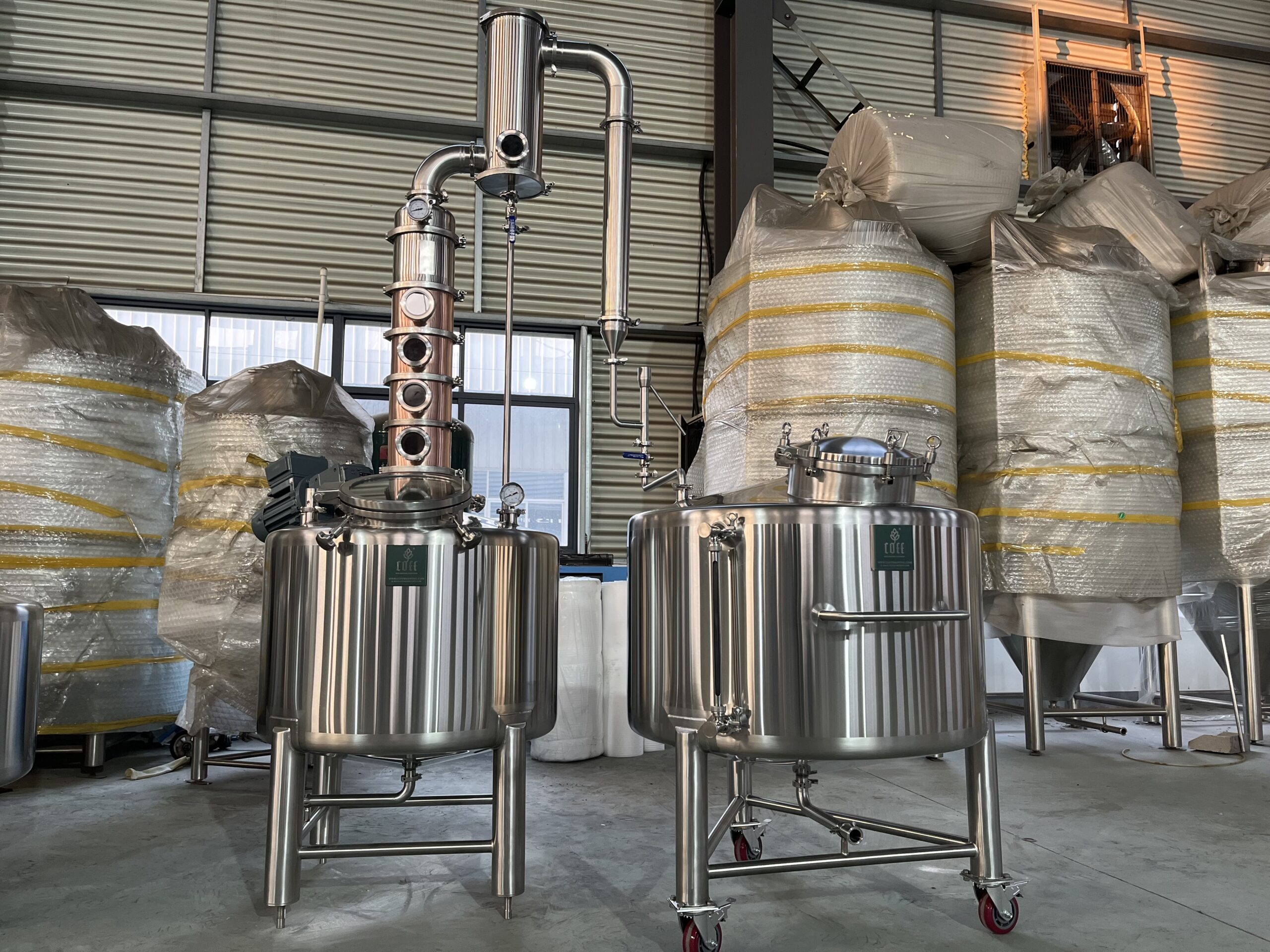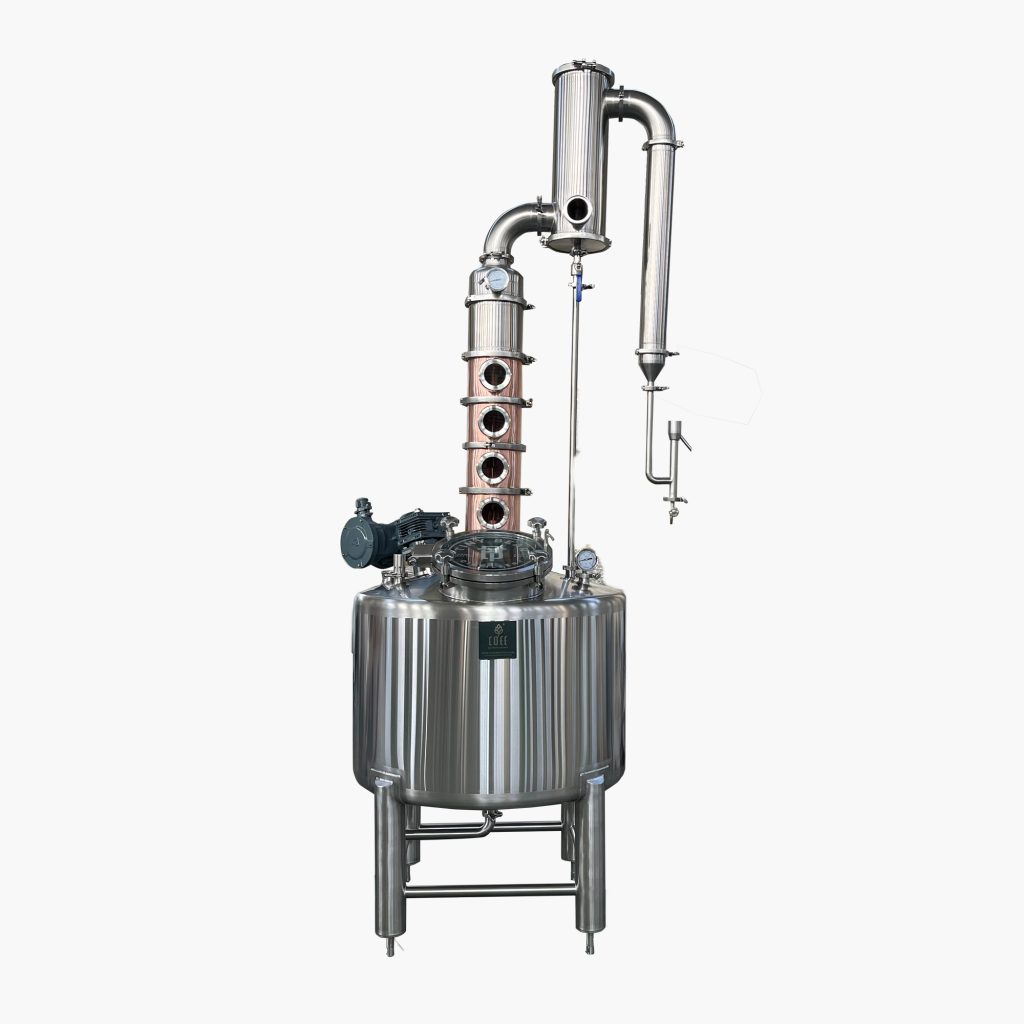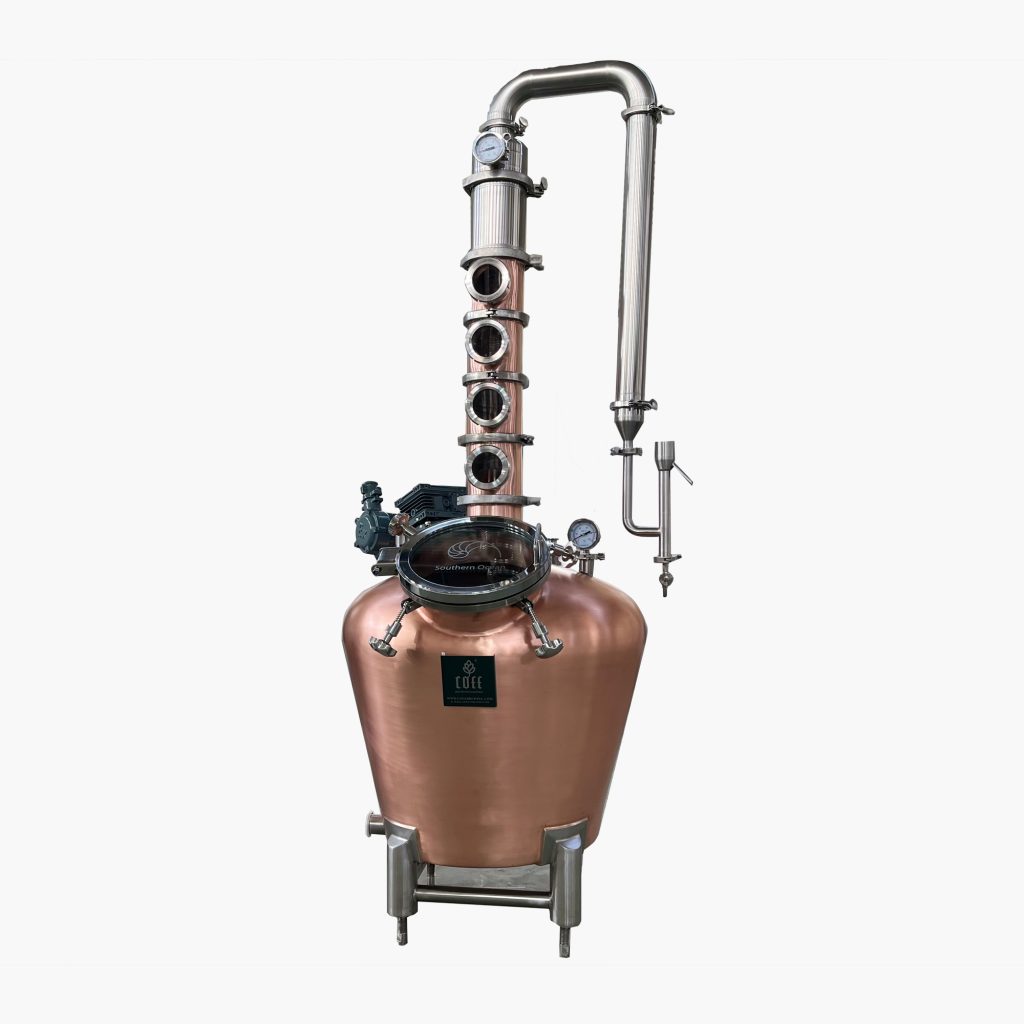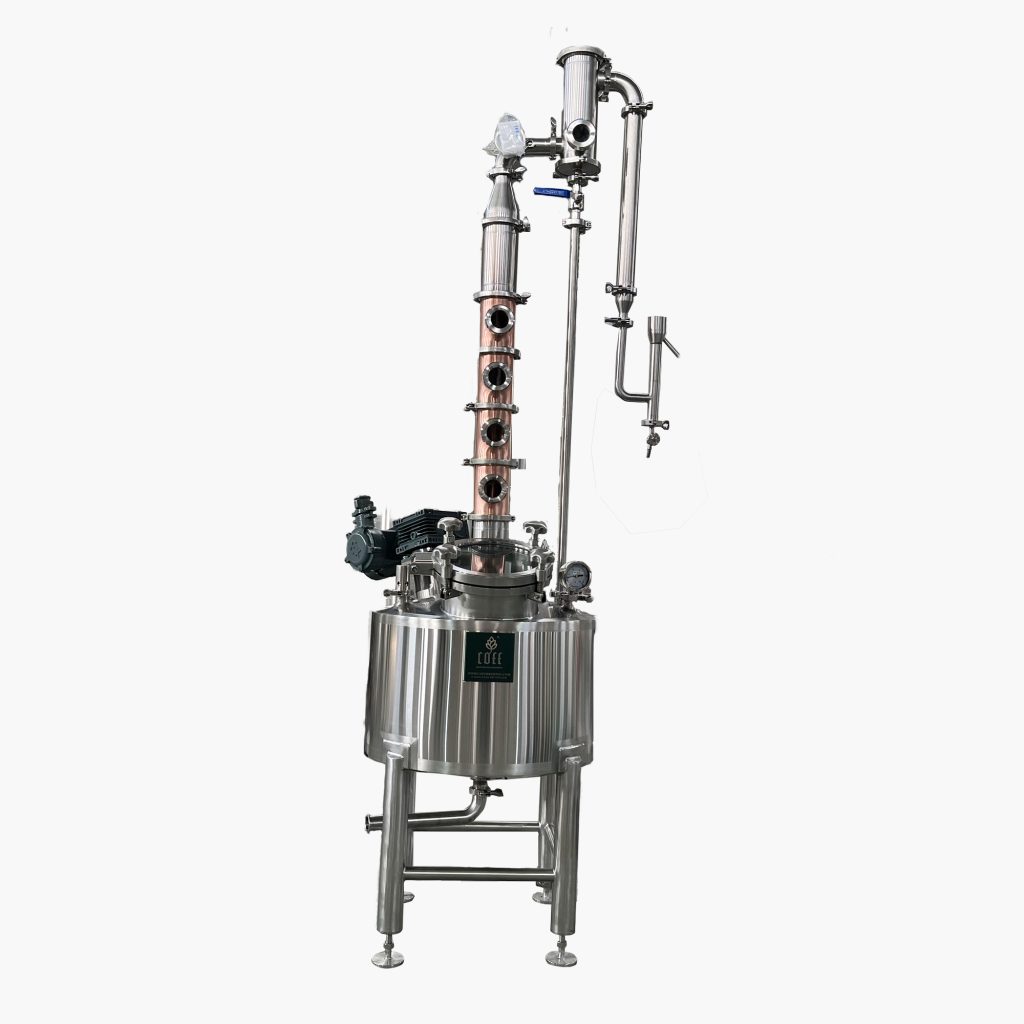マイクロ・ディスティラリー設備
Whiskey Distilleries
Whiskey distilleries require a variety of specialized whisky distillery equipment to produce whiskey.
1. Milling Equipment
Grain Mill: Used to crush and grind grains (such as barley, corn, rye, or wheat) into a coarse powder called grist. This increases the surface area for the subsequent mashing process.
2. Mashing Equipment
Mash Tun: A large vessel where the grist is mixed with hot water to convert starches into fermentable sugars. The mixture is heated, and enzymes break down the starches.
3. Fermentation Equipment
Fermentation Tanks: Vessels (often made of stainless steel or wood) where yeast is added to the mash to ferment the sugars into alcohol. This process typically takes several days and produces a liquid called “wash” with low alcohol content.

4. Distillation Equipment
Pot Still: A traditional type of still used for distilling whiskey. It consists of a large pot where the wash is heated, and the alcohol vapor rises and condenses in a condenser. Pot stills are often used for single malt whiskies.
Column Still (Continuous Still): A more modern type of still that allows for continuous distillation. It consists of a tall column with multiple plates that separate alcohol from the wash. This method is often used for producing grain whiskey.
5. Cooling Equipment
Condenser: A device that cools the alcohol vapor back into liquid form after distillation. It typically uses water to cool the vapor.
6. Cleaning and Maintenance Equipment
Cleaning Systems: Equipment for cleaning and sanitizing tanks, pipes, and other equipment to ensure hygiene and prevent contamination.
7. Storage Facilities
Warehouse: A controlled environment for storing barrels during the aging process. Temperature and humidity can significantly affect the aging of whiskey.
Vodka Distilleries
Vodka distilleries, like whiskey distilleries, are facilities where spirits are produced, but the processes and equipment can differ significantly due to the nature of vodka production. Here’s an overview of vodka distilleries, including the vodka distillery equipment typically used in the production process.
Overview of Vodka Distilleries
Vodka is a clear, neutral spirit that can be made from a variety of raw materials, including grains (like wheat, rye, or corn), potatoes, and even fruits. The production process generally involves fermentation, distillation, and filtration.
Key Equipment Used in Vodka Distilleries
Milling Equipment
Grain Mill: Similar to whiskey production, grains are milled to create a coarse powder, which increases the surface area for the mashing process.
Mashing Equipment
Mash Tun: A vessel where the milled grains or other raw materials are mixed with hot water to convert starches into fermentable sugars. This process is crucial for grain-based vodkas.
Fermentation Equipment
Fermentation Tanks: These are typically stainless steel tanks where yeast is added to the mash to ferment the sugars into alcohol. The fermentation process for vodka is usually shorter than for whiskey.
Distillation Equipment
Column Still (Continuous Still): Vodka is often distilled multiple times to achieve a high level of purity and neutrality. Column stills are commonly used for this purpose, allowing for continuous distillation and efficient separation of alcohol from impurities.
Pot Still: Some artisanal vodka producers may use pot stills for a more traditional approach, although this is less common for mass production.
Cooling Equipment
Condenser: Similar to whiskey production, condensers are used to cool the alcohol vapor back into liquid form after distillation.
Filtration Equipment
Filtration Systems: Vodka is often filtered multiple times to remove impurities and achieve a smooth, clean taste. This can include activated carbon filters, charcoal filters, or other specialized filtration methods.
Storage Facilities
Storage Tanks: Large tanks for holding the distilled vodka before bottling. These tanks are often made of stainless steel to prevent contamination.
Rum Distilleries
Rim is a kind of spiritual wine, and its flavor and style will be very different due to the different raw materials, fermentation processes and aging conditions. Rum is mainly produced in tropical areas growing sugarcane. The Rum Wine Brewery uses various professional rum distillery equipment to produce this extensive use of spirits.
Key Equipment Used in Rum Distilleries
Milling Equipment
Sugarcane Crusher: A machine used to crush sugarcane to extract the juice. This juice can be fermented directly to produce rum, or it can be boiled down to create molasses.
Fermentation Equipment
Fermentation Tanks: Vessels (often made of stainless steel or wood) where the sugarcane juice or molasses is mixed with water and yeast. The fermentation process converts sugars into alcohol, typically taking several days.

Brewing Stills
Pot Still: A traditional type of still often used for producing artisanal or high-quality rums. It consists of a large pot where the fermented wash is heated, and the alcohol vapor rises and condenses.
Column Still (Continuous Still): More commonly used in larger rum production facilities, column stills allow for continuous distillation, producing a higher alcohol content and a cleaner spirit.
Cooling Equipment
Condenser: A device that cools the alcohol vapor back into liquid form after distillation, similar to those used in whiskey and vodka production.
Storage Facilities
Storage Tanks: Large tanks for holding the distilled rum before bottling. These tanks are often made of stainless steel to prevent contamination.

Gin Distilleries
Gin distilleries produce gin, a spirit that is primarily flavored with juniper berries and other botanicals. The production process for gin involves distillation, and it can be made using various base spirits, including grain or malt.
Key Gin Distillery Equipment
Milling Equipment
Grain Mill: If the gin is produced from grains, a mill is used to crush and grind the grains into a coarse powder, increasing the surface area for mashing.
Fermentation Equipment
Fermentation Tanks: Vessels where yeast is added to the mash or wash to ferment the sugars into alcohol. This process typically takes several days.
Distillation Equipment
Pot Still: A traditional still used for distilling gin, especially in smaller or craft distilleries. The wash is heated, and the alcohol vapor rises and condenses.
Column Still (Continuous Still): More commonly used in larger gin production, column stills allow for continuous distillation, producing a higher purity spirit.
Gin Basket
Botanical Basket: A specialized component often placed in the still where botanicals (such as juniper, coriander, citrus peels, and other herbs) are added. The alcohol vapor passes through the botanicals, extracting their flavors during distillation.
Cooling Equipment
Condenser: A device that cools the alcohol vapor back into liquid form after distillation.
Storage Facilities
Storage Tanks: Large tanks for holding the distilled gin before bottling. These tanks are often made of stainless steel to prevent contamination.
Explore Micro Distillery Equipment Options
Micro distillery equipment is designed for small-scale production of spirits, allowing craft distillers to create high-quality products with unique flavors. Here are some key features and components typically found in craft distillery equipment:

1. Still
Type: Pot stills or column stills, depending on the desired spirit.
Material: Usually use stainless steel distillation equipment or copper distillation equipment for better heat conduction and flavor.
Size: Ranges from small (5-50 gallons) to larger capacities (up to 500 gallons).
Heating Source: Electric, steam, or direct fire options.
2. Mash Tun
Function: Used for mashing grains or other fermentable materials.
Insulation: Often insulated to maintain temperature during mashing.
Agitation: Equipped with a stirring mechanism to ensure even mixing.

4. Cooling System
Condenser: Essential for cooling vapor back into liquid; can be air-cooled or water-cooled.
Chiller Units: May be included for more efficient cooling processes.
5. Filtration System
Carbon Filters: Used to remove impurities and improve flavor.
Other Filtration Methods: May include plate filters or depth filters.
6. Bottling Equipment
Filling Machines: Semi-automatic or automatic systems for filling bottles.
Capping Machines: For sealing bottles with caps or corks.
Labeling Machines: For applying labels to finished products.
7. Storage Tanks
Material: Usually stainless steel for durability and ease of cleaning.
Capacity: Varies based on production needs; can be used for aging spirits or storing finished products.
8. Control Systems
Digital Controls: For monitoring temperature, pressure, and other variables.
Automation: Some systems offer automated processes for efficiency.
9. Safety Features
Pressure Relief Valves: To prevent over-pressurization.
Temperature Sensors: To monitor and control heat levels.
Emergency Shut-off Systems: For quick response in case of malfunction.
10. Cleaning Equipment
CIP (Clean-in-Place) Systems: For easy cleaning of tanks and pipes without disassembly.
Sanitizing Equipment: To ensure all surfaces are safe for food production.
11. Additional Accessories
Hydrometers and Refractometers: For measuring alcohol content and sugar levels.
Thermometers: For monitoring temperatures during various processes.
Pumps: For transferring liquids between vessels.
How to distill spirits?
Distilling spirits is a complex process that requires careful attention to detail, knowledge of equipment, and understanding the laws and regulations in your area. Here are the steps involved in distilling different spirits:
How to make rum with micro distillery equipment
The process of making rum involves several stages, from raw material preparation to fermentation, distillation and final bottling. Here are the detailed steps for making rum using micro distillation equipment:
Sugar source: Rum is usually made from cane juice, molasses or sugar. Selecting high-quality ingredients is key.
Water: Use clean water, preferably dechlorinated water, to avoid affecting the flavor of fermentation and distillation.
If using molasses, use it directly. If using sugar cane, press the cane to extract the juice.
Fermentation vessel: Pour molasses or sugar cane juice into the fermentation vessel and add yeast. You can choose yeast specifically for rum to get a better flavor.
Fermentation: Allow the mixture to ferment at a comfortable temperature (usually between 20-30°C). Fermentation usually takes a few days to a few weeks, depending on the temperature and the activity of the yeast. Once fermentation is complete, the sugars are converted into alcohol, which usually produces an alcohol concentration between 5% and 10%.
Prepare the distillation equipment: Pour the fermented liquid (called the “wash”) into the stainless distilling equipment.
First distillation:
By heating the wash solution, the alcohol will evaporate and cool through the condenser to form a liquid.
Collect the first distilled liquid, usually called “low wine”, which contains alcohol and other volatile components.
Second distillation (rectification):
The first distilled liquid is poured into the still again for rectification to separate the purer alcohol.
At this stage, the temperature is monitored and the “heads” (low-boiling volatiles, usually containing undesirable ingredients), the “heart” (good alcohol) and the “tails” (high-boiling ingredients) are separated. Only the “heart” is kept for the final product.
Seasoning: You can add spices, peels or other ingredients to season according to your personal taste.
Aging: The rum is aged in oak barrels to add flavor and complexity. Aging time can range from a few months to several years.
Before bottling, the rum may be filtered to remove impurities.
Dilute with water as needed to desired alcohol concentration (usually between 40%-50%).
Pour the rum into clean bottles, seal and label them. Make sure the label includes the alcohol content, production date and other relevant information.
After use, clean all equipment thoroughly to prevent cross contamination and keep the equipment in good condition.
Legal Compliance: Make sure you follow local laws and regulations. Many places have strict regulations on home brewing and distilling.
Safety: Perform distillation in a well-ventilated area to avoid risk of fire and explosion.
– Federal Laws: In the U.S., distilling alcohol for personal use is illegal without a permit. The Alcohol and Tobacco Tax and Trade Bureau (TTB) regulates distillation.
– State Laws: Each state has its own regulations regarding distillation. Some states may allow home distilling for personal use, while others do not.
– Form TTB F 5110.74: This is the application for a distilled spirits plant (DSP) permit.
– Prepare Documentation: You’ll need to provide information about your distillation operation, including:
– Business structure (individual, partnership, corporation)
– Location of the distillery
– Equipment details
– Production capacity
– Submit the Application: Send your completed application to the TTB. There may be a fee involved.
– Check State Regulations: Research your state’s specific requirements for distilling alcohol. You may need additional permits or licenses.
– Local Zoning Laws: Ensure your distillation operation complies with local zoning laws.
– You may need to comply with health and safety regulations, which could involve inspections and permits from local health departments.
– The approval process can take several months. Be prepared for potential follow-up questions or requests for additional information from the TTB or state authorities.
– Once you receive your permits, maintain accurate records of your production, sales, and any other required documentation to remain compliant with federal and state laws.
– Consider consulting with a lawyer or a professional who specializes in alcohol law to navigate the complexities of the permitting process.
Important Notes:
– Distilling alcohol without the proper permits can lead to severe penalties, including fines and imprisonment.
– Always stay updated on changes in laws and regulations, as they can vary significantly by location.
Make sure to do thorough research and follow all legal requirements to ensure a successful application process.





